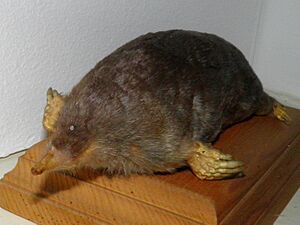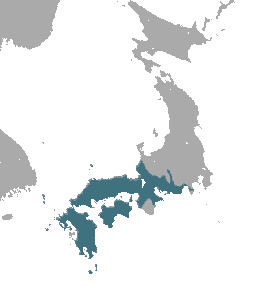Japanese mole facts for kids
Quick facts for kids Japanese mole |
|
|---|---|
 |
|
| Conservation status | |
| Scientific classification | |
 |
|
| Japanese mole range | |
| Synonyms | |
|
Mogera kobeae Thomas, 1905 |
The Japanese mole (Mogera wogura) is a type of mole that lives only in Japan. It's also called Temminck's mole. These moles usually live alone and are active during the day. They can live for about 3.5 years in nature. Their size can change based on how warm it is and how hard the soil is where they live. What was once called the Kobe mole (M. kobeae) is now known to be the same species as the Japanese mole.
Scientists believe the Japanese mole's ancestors arrived in Japan a long time ago. This was between 100,000 and 10,000 years ago, around the last big ice age. Over time, different groups of Japanese moles have shown small changes in their genes. This is especially true for their teeth, which look a bit different depending on where the mole lives.
How Japanese Moles Move
The Japanese mole (Mogera wogura) moves in two main ways: by crawling and by digging tunnels. These movements show how well their bodies are designed for life underground. The mole's brain has very strong connections to its front and back legs. These connections help the mole move powerfully. They use their strong legs to push away loose dirt, almost like they are swimming through the soil.
Japanese Mole Reproduction
Scientists have studied different types of moles, including the Japanese mole. They found that most Mogera species usually have their babies in the spring. However, in 2004, something interesting happened in western Japan. Three young Japanese moles were found in their nest in October. Also, a male mole ready to mate and a female mole feeding her babies were found in September and October. This suggests that sometimes, Japanese moles might reproduce outside of the usual spring season.


